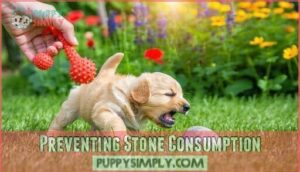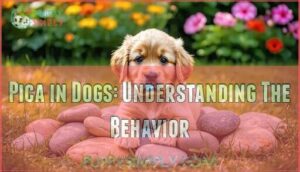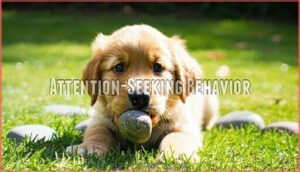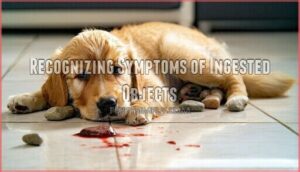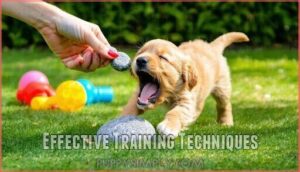This site is supported by our readers. We may earn a commission, at no cost to you, if you purchase through links.
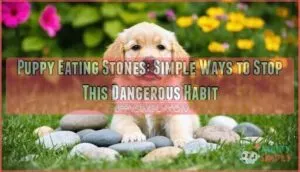 If you catch your puppy eating stones, you’re not alone. Puppies often use their mouths to explore, but munching on rocks can lead to big trouble—think upset tummies or worse.
If you catch your puppy eating stones, you’re not alone. Puppies often use their mouths to explore, but munching on rocks can lead to big trouble—think upset tummies or worse.
Sometimes, boredom, teething, or even a missing nutrient sparks this rocky habit. Try swapping stones for safe chew toys and keep walks on a short leash.
Teaching “leave it” works wonders, too. If your pup keeps at it or seems unwell, a vet visit is smart.
The world’s full of strange snacks for a curious pup, but there are clever ways to keep those stones off the menu.
Table Of Contents
- Key Takeaways
- Reasons Behind Stone Ingestion
- Preventing Stone Consumption
- Addressing Swallowed Stones
- Pica in Dogs: Understanding The Behavior
- Managing Dogs’ Ingestion of Inedible Items
- Curbing Dogs’ Appetite for Non-Food Items
- Recognizing Symptoms of Ingested Objects
- Effective Training Techniques
- Consequences of Swallowing Foreign Objects
- Seeking Professional Help and Safety Measures
- Frequently Asked Questions (FAQs)
- Will eating stones harm my puppy?
- How do I get my puppy to stop eating rocks?
- Why is my 8 week old puppy eating rocks?
- What if my puppy swallowed a small stone?
- Can stone eating affect a puppys dental health?
- What are long-term effects of repeated stone ingestion?
- How do veterinarians diagnose stone-related health issues?
- Are certain environments riskier for stone eating?
- Can stone eating behavior return after being stopped?
- Conclusion
Key Takeaways
- Watch your puppy closely—eating stones can cause blockages, dental injuries, or worse, so call your vet if it happens.
- Swap rocks for safe chew toys, teach the “leave it” command, and keep walks supervised to stop the habit.
- Make sure your pup’s food meets their nutritional needs—deficiencies or boredom often trigger stone eating.
- Act fast if your puppy swallows a stone; look for vomiting, lethargy, or appetite loss, and get veterinary help right away.
Reasons Behind Stone Ingestion
When puppy curiosity meets everything-goes-in-the-mouth exploration, stones become tempting targets.
Teething discomfort drives pups to chew anything for relief, while nutritional deficiencies can trigger cravings for minerals found in rocks.
Puppies chew on rocks to soothe sore gums or satisfy cravings from missing nutrients.
Anxiety triggers and boredom also fuel this risky behavior. The pica condition makes some dogs compulsively eat non-food items.
Understanding these puppy behavioral issues helps you tackle the root cause before puppy health risks and digestive issues develop, which can be influenced by nutritional deficiencies.
Preventing Stone Consumption
You can stop your puppy from eating stones by addressing the root causes and creating better habits.
Start with proper nutrition, mental stimulation, and consistent training to redirect this dangerous behavior.
Balanced Nutrition
Why settle for subpar puppy food when your growing pup needs premium nutrition? Quality matters in meeting your puppy’s dietary requirements.
High-grade puppy food contains essential nutrients that support ideal growth and proper mineral absorption. When puppies lack key vitamins and minerals, they’ll seek them elsewhere—including stones and dirt.
Puppy nutritional needs differ substantially from adult dogs. They require higher protein, fat, and calorie content to fuel rapid development.
Nutrient deficiency, particularly puppy mineral deficiency, can trigger unusual eating behaviors. Iron, zinc, and calcium deficiencies commonly lead to pica.
Choose food quality that meets AAFCO standards for growth and reproduction. Feed consistent portions at regular intervals to prevent hunger-driven scavenging.
Don’t forget hydration importance—fresh water should always be available. Address puppy dietary deficiencies early by consulting your vet about appropriate supplements if needed.
Ensuring puppy balanced nutrition is essential for their well-being.
Combatting Boredom
Boredom can turn even the sweetest puppy into a stone-seeking troublemaker.
When your pup lacks proper mental stimulation, those rocks start looking like fascinating chew toys. Combat this destructive habit with engaging activities that tire their mind and body.
Here are four effective boredom-busters:
- Puzzle Toys – Hide treats inside interactive games that challenge problem-solving skills
- Exercise Variety – Mix walks with fetch, tug-of-war, and running games
- Mental Stimulation – Practice basic commands and teach new tricks daily
- Enrichment Activities – Rotate chew toys weekly to maintain novelty and interest
Consider purchasing interactive dog puzzles to keep your dog engaged.
Breed-Specific Considerations
When breed predispositions come into play, understanding your pup’s genetic factors can be a game-changer.
Some breeds are naturally wired to mouth everything in sight.
Retrievers and Spaniels top the list for stone ingestion puppies, thanks to their "carry everything" instincts.
Meanwhile, Border Collies and German Shepherds often develop puppy pica when their big brains aren’t challenged enough.
High-energy breeds need extra breed activity to prevent puppy eating stones.
A bored Husky will find trouble faster than you can say "rock collection."
Breed anxiety also plays a role—some dogs stress-eat stones like we stress-eat ice cream.
A key factor can be addressing potential nutritional deficiencies.
Don’t forget breed diet considerations either.
Working breeds burn through calories quickly and might seek minerals from stones if their nutrition falls short.
Addressing these puppy health concerns early prevents serious puppy digestive issues down the road.
Teething Solutions
Teething transforms your sweet puppy into a chewing machine, making stones look tempting when their gums ache. Smart solutions can redirect this behavior before puppy eating stones becomes a dangerous habit.
Frozen chew toys work wonders for teething pain relief. The cold numbs sore gums while satisfying your pup’s need to gnaw. Cold food options like frozen carrots or ice cubes provide natural alternatives that won’t splinter.
Here are teething essentials that prevent puppy chewing rocks:
- Puppy-safe options like rubber teething rings designed for small mouths
- Gum massage using your finger wrapped in damp cloth to soothe inflammation
- Teething-specific diets with softer kibble that’s easier on tender gums
Monitor your puppy closely during this phase. Consider purchasing durable puppy toys to help them through this stage. Puppy pica often starts when teething discomfort drives them toward inappropriate items. Replace any damaged toys immediately to prevent puppy digestive issues from swallowed pieces.
Training Leave It Command
Teaching your puppy the "leave it" command transforms stone-eating disasters into training victories. This essential puppy training skill requires Command Consistency across all family members.
Start with high-value treats your pup can’t resist, then practice Gradual Progression from easy to challenging scenarios.
| Training Stage | What to Expect |
|---|---|
| Week 1-2 | Your puppy ignores the command completely (don’t panic—this is normal!) |
| Week 3-4 | Hesitation appears—they’ll pause before grabbing that tempting rock |
| Week 5+ | Victory dance time—reliable response to "leave it" in most situations |
Smart Treat Selection matters. Use something irresistible during training sessions. Practice Distraction Training by placing stones nearby while teaching the command.
Work on Generalization Skills by practicing in different locations—your backyard, walks, and parks. Remember, puppy eating rocks behavior won’t vanish overnight. These puppy training tips require patience, but consistent dog training creates lasting results.
Your dedication pays off when your pup automatically responds to leave it commands.
Addressing Swallowed Stones
Emergency action beats regret when your puppy swallows stones.
Act fast—your quick response could save your puppy from serious danger if they swallow a stone.
Contact your veterinarian immediately for damage assessment and veterinary consultation.
Watch for obstruction symptoms like vomiting, loss of appetite, or lethargy – these signal potential intestinal obstruction requiring urgent care.
Your vet will determine if surgical intervention is necessary based on the stone’s size and location.
Post-ingestion care involves monitoring your pup closely and following professional guidance.
Health risks from puppy rock eating include serious digestive blockages that can be life-threatening without prompt treatment.
Pica in Dogs: Understanding The Behavior
When your puppy constantly chews on rocks, they might’ve pica—a condition where dogs eat non-food items. This behavior stems from curiosity, boredom, or missing nutrients in their diet.
Curiosity and Exploration
Puppy curiosity drives them to explore everything through their mouths, turning your backyard into their personal taste-testing ground.
This natural puppy behavior stems from their need for sensory input during early development.
Understanding why puppies engage in environmental interaction helps you redirect their oral fixation toward safer options.
Here’s what fuels your puppy’s rock-eating adventures:
- Sensory exploration – Puppies learn about texture, temperature, and taste through mouthing objects
- Natural development – Early development requires investigating new environments and materials
- Puppy curiosity – Everything seems interesting when you’re discovering the world for the first time
- Oral fixation needs – Puppies naturally want to chew and mouth objects constantly
- Environmental interaction – Exploring surroundings helps puppies understand their territory and surroundings
This puppy exploration phase means they’ll investigate rocks, sticks, and other tempting items.
Addressing this habit can help prevent dog behaviour problems.
Recognizing these puppy eating habits as normal behavior helps you stay patient while redirecting their attention to appropriate chew toys.
Boredom as a Trigger
Boredom strikes when your puppy lacks mental stimulation and physical activity.
Without proper exercise importance and interactive toys, puppies often turn to stones as entertainment. This destructive puppy behavior stems from routine changes and insufficient mental enrichment.
| Boredom Signs | Quick Fixes | Long-term Solutions |
|---|---|---|
| Stone chewing | Fetch games | Daily walk schedule |
| Destructive behavior | Puzzle toys | Training classes |
| Excessive energy | Hide treats | Dog sports |
| Attention seeking | Interactive play | Mental challenges |
Combat lack of stimulation with engaging activities that redirect your puppy’s focus from stones to appropriate outlets.
Dietary Deficiencies and Compulsions
Beyond boredom, your puppy’s stone-eating habit might stem from deeper nutritional issues.
When dogs can’t absorb nutrients properly, they’ll search for missing minerals in strange places.
Here’s what drives these dietary deficiencies and compulsions:
- Nutrient Absorption problems prevent your pup from getting essential vitamins and minerals from their regular diet
- Mineral Imbalance creates cravings that make stones seem appealing as a supplement source
- Gut Microbiome disruption affects how well your dog processes food and absorbs nutrients
- Enzyme Deficiency blocks proper digestion, leaving your puppy seeking alternatives like stones
Dog pica often signals nutritional deficiency in your puppy diet.
Sometimes, it can even be triggered by medical conditions like Cushing’s disease.
Check with your vet about craving solutions that address the root cause.
Managing Dogs’ Ingestion of Inedible Items
Your puppy’s stone-eating habit might stem from attention-seeking behavior or fascination with buried treasures in your yard.
Understanding these specific triggers helps you address the root cause and keep your furry friend safe from dangerous ingestion.
Attention-Seeking Behavior
Some puppies turn stone-eating into a performance, realizing it gets your attention fast.
When you react strongly to unusual puppy behavior, your puppy learns that chewing rocks equals instant focus from you. This creates learned associations between destructive actions and owner reactions.
| Attention Pattern | Puppy’s Learning |
|---|---|
| Shouting "No!" | Gets immediate response |
| Chasing puppy | Fun game begins |
| Inconsistent attention | Confusion about rules |
| Calm redirection | Clear boundaries set |
Your puppy doesn’t care if attention is positive or negative—they just want your eyes on them. Inconsistent attention makes this worse. One day you laugh, the next you panic. This mixed messaging teaches your puppy that eating stones is unpredictable but always interesting.
Addressing these issues early on can prevent advanced behavioral problems. Redirecting focus works better than dramatic reactions. When you spot your puppy eyeing rocks, calmly offer a toy instead. Ignore the unwanted behavior while rewarding good choices. This approach reduces anxiety and teaches better habits without turning stone-eating into a game.
Soil and Buried Objects
When attention-seeking behavior isn’t the culprit, dogs often turn their focus underground.
Soil composition can hide various buried dangers that attract curious pups through scent detection.
Your puppy’s digging behavior might uncover stones mixed with environmental toxins or decomposing materials.
Watch for signs your dog is eating soil along with stones – this combo screams pica to your veterinarian.
The underground buffet includes rocks, old bones, and mystery objects that smell fascinating to puppy noses.
Create barriers around problem digging spots using chicken wire or decorative fencing.
Redirect that digging energy with sandbox alternatives filled with safe toys.
When you catch your pup mid-excavation, use positive commands like "leave it" instead of scolding.
Regular yard sweeps help remove accessible stones before they become snacks.
Curbing Dogs’ Appetite for Non-Food Items
Stone eating isn’t your puppy’s only dangerous dining choice – many dogs also target sticks, garbage, and even dead animals they find outdoors.
These items pose serious health risks including choking, intestinal blockages, and toxic poisoning that can require emergency surgery.
Sticks, Trash, and Carcasses
Your pup’s outdoor adventures don’t stop at stones. Sticks, trash, and decomposing animals present serious ingestion hazards that require immediate attention. Scavenging risks multiply when curious puppies explore your yard, where toxic materials and parasite exposure lurk around every corner.
Here’s how to stop puppy eating these dangerous items:
- Remove sticks daily – Check your yard for fallen branches and debris
- Secure trash cans – Use tight-fitting lids to prevent scavenging behavior
- Clear dead animals immediately – Decomposition dangers include bacteria and parasites
- Teach "leave it" consistently – Practice this command during every walk
- Provide safe chew alternatives – Redirect your puppy’s natural chewing instincts
Remember, pica behaviors often stem from boredom or nutritional gaps. Creating a hazard-free environment while addressing underlying causes helps break the cycle of eating non-food items before they become ingrained habits.
Risks of Foreign Body Ingestion
When your puppy swallows stones, you’re facing serious health risks that demand immediate attention.
Intestinal obstruction tops the danger list, potentially blocking food passage and requiring emergency surgery.
These blockages can trigger peritonitis risk if stones puncture intestinal walls, spreading infection throughout your puppy’s abdomen.
Dental damage occurs when stones crack or chip teeth during chewing.
Sharp edges can cause esophageal injury as stones travel down your puppy’s throat.
Some stones carry toxic exposure risks from chemicals or contaminated surfaces.
Puppy stomach problems develop quickly after ingestion.
Watch for vomiting, lethargy, or loss of appetite – these signal potential intestinal blockages requiring veterinary intervention.
Prevention beats treatment every time, and being aware of these risks can help you take immediate action to protect your puppy.
Recognizing Symptoms of Ingested Objects
When your puppy’s playful curiosity leads to stone swallowing, quick action saves lives.
Watch for these telltale signs that demand immediate veterinary attention. Lethargy and Vomiting often appear first, followed by Abdominal Tenderness when you gently touch their belly. Appetite Loss signals serious trouble, while Changes in Stool or Difficulty Defecating indicate blockages.
Don’t wait—puppy stomach problems from eating stones worsen rapidly.
Here are five warning signs that’ll break your heart if ignored:
- Your once-energetic pup lies motionless, eyes glazed with pain
- Desperate whimpering when you touch their swollen belly
- Food bowl sits untouched for hours—unthinkable for most puppies
- Straining unsuccessfully in the yard, tears in their eyes
- Blood-tinged vomit that makes your stomach drop
Contact your veterinarian immediately when these symptoms appear.
Effective Training Techniques
Training your puppy to stop eating stones requires consistent commands and positive rewards.
The "leave it" command becomes your most powerful tool, while reward-based methods help your puppy learn what behaviors earn praise and treats.
Teaching Leave It Command
Noticing your dog sniffing around for trouble? Teaching the “leave it” command can save your shoes—and your puppy’s belly—from a world of hurt.
Start with Command Consistency. Use a simple treat in your closed hand. When your puppy tries to eat it, say “leave it.” The moment they back off, reward with a different treat.
Mix up Treat Variations to keep things interesting. Move to Leash Training and Distraction Training outside, where stones lurk.
Practice in new places for strong Generalization Skills. Always praise good choices. With patience and practice, your puppy will learn that eating stones is off-limits, no matter where you roam.
Positive Reinforcement Methods
Once your dog starts to get the hang of the “leave it” command, it’s time to make things more fun and rewarding. Positive reinforcement methods are your best friend here.
Reward Systems like treats, clicker training, and a cheerful “good job!” work wonders. Shaping behavior is all about catching your puppy doing the right thing and rewarding it right away.
Try these tricks:
- Use high-value treats for ignoring stones
- Clicker training to mark good choices
- Positive commands paired with praise
- Redirecting focus with a favorite toy
Timing matters—reward right after the good behavior. With patience and consistency, you’ll see less stone chewing and better dog behavior every day.
Consequences of Swallowing Foreign Objects
When your puppy swallows stones or other odd objects, you’re staring down a real can of worms. Besides the obvious risk of choking, you could be dealing with an Intestinal Blockage or even Esophageal Damage.
Left unchecked, these problems can spiral into Peritonitis Risk—a serious infection that’s no walk in the park. Sometimes, Emergency Surgery is the only way out, especially if food and water can’t pass through.
Stones can cause dental fractures, too, making mealtimes a pain. Don’t forget about Toxic Exposure if the object’s been somewhere nasty.
Here’s a quick breakdown:
| Symptom | What It Means |
|---|---|
| Vomiting | Gastrointestinal disease, blockage warning |
| Lethargy | Intestinal obstruction danger |
| Drooling | Esophageal damage |
| Restlessness | Pain or discomfort |
| Loss of appetite | Emergency clinic time |
Stay alert—your puppy’s health depends on it.
Seeking Professional Help and Safety Measures
If your puppy swallows stones, don’t play the guessing game—reach out for a veterinarian consultation right away.
Emergency preparedness matters, especially if you suspect an intestinal obstruction. Safe environments and close supervision help, but sometimes you need backup.
Remember that knowing canine CPR techniques can be life-saving in critical situations.
Here’s what you can do:
- Connect with professional trainers or behavioral therapy experts for hands-on help.
- Keep the number of your local emergency clinic handy.
- Use pet-safe deterrent sprays and block stone-filled areas.
Stay proactive—your quick action can save your puppy from serious trouble.
Frequently Asked Questions (FAQs)
Will eating stones harm my puppy?
Jumping into the Stone Age isn’t safe—eating stones can block your puppy’s gut or break teeth.
If you catch your furry explorer munching rocks, call your vet right away. Don’t wait for a disaster.
How do I get my puppy to stop eating rocks?
Try swapping rocks for chew toys, teach the “leave it” command, and keep walks supervised.
Remove stones from your yard.
If your pup’s still munching rocks, check with your vet—sometimes it’s more than curiosity.
Why is my 8 week old puppy eating rocks?
Curiosity killed the cat, but your 8-week-old pup’s just exploring the world—sometimes with their mouth.
It could be teething, boredom, or even a nutrient gap.
Keep an eye out and chat with your vet.
What if my puppy swallowed a small stone?
If your puppy swallowed a small stone, don’t wait for nature to “sort it out.”
Call your vet right away. Stones can block or damage the gut.
Quick action beats playing detective with puppy poop any day!
Can stone eating affect a puppys dental health?
About 30% of dental injuries in dogs come from chewing hard objects like stones.
If your pup gnaws on rocks, watch out for cracked or worn teeth—those little “pebbles” can pack a painful punch!
What are long-term effects of repeated stone ingestion?
Repeated stone eating can cause blocked intestines, worn or broken teeth, and even long-term stomach problems.
You might face big vet bills and lots of worry.
It’s like rolling the dice with your dog’s health every time. You might face big vet bills and lots of worry.
How do veterinarians diagnose stone-related health issues?
Like a detective piecing together clues, your vet will ask about symptoms, check your dog, and may use X-rays or ultrasounds.
Blood tests help too, this way, they spot blockages or injuries from stone munching.
Are certain environments riskier for stone eating?
Gravel driveways, rocky yards, or parks with loose stones are like candy stores for curious pups.
When you’re outdoors, keep an eye out—these spots make it easy for dogs to snack on rocks without warning.
Can stone eating behavior return after being stopped?
About 30% of dogs who stop eating stones may pick up the habit again if old triggers return.
So, keep your guard up—change routines, offer toys, and stay watchful during walks to keep those pebbles off the menu, especially to prevent them from becoming a habit again.
Conclusion
Did you know nearly 10% of puppies try eating stones at some point?
If your puppy eating stones has you worried, you’re not alone. By offering safe chew toys, teaching “leave it,” and keeping walks supervised, you can help your pup break the habit.
Watch for signs your puppy swallowed something and call the vet if needed. With patience and a few smart changes, you’ll keep your curious friend safe from rocky snacks and bigger problems.

